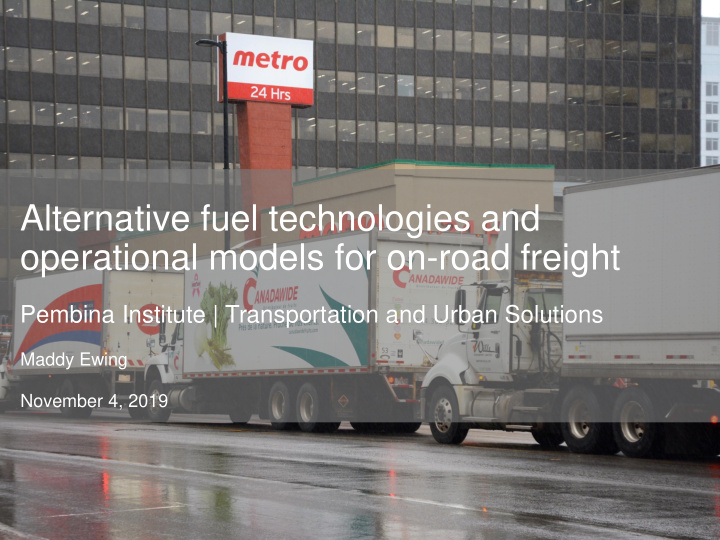



Alternative fuel technologies and operational models for on-road freight Pembina Institute | Transportation and Urban Solutions Maddy Ewing November 4, 2019
Leading Canada’s transition to clean energy The Pembina Institute is a non-profit think-tank that advocates for strong, effective policies to support Canada's clean energy transition. 2
Context On-road freight 3
4
5
Trucking is a growing source of GHG emissions in Ontario Source: NRCAN Comprehensive Energy Use Database 6
Working towards the decarbonization of Ontario’s freight sector 7
Reducing GHG emissions from freight Technology options and operational practices 8
On-road freight is diverse Varies by: 1. Size 2. Operations 3. Geographic scope 4. Type of goods moved A need for situation-specific strategies 9
On-road freight is diverse Varies by: 1. Size 2. Operations 3. Geographic scope 4. Type of goods moved A need for situation-specific strategies 10
Different solutions for different realities Long haul Regional Urban Fuel saving devices Battery electric vehicles Hydrogen fuel cell vehicles Renewable natural gas vehicles Biofuels Cargo bikes 11
Key barriers to success of low- carbon technologies Availability of refueling infrastructure Vehicle costs Fuel costs Fuel availability 12
Operational practices to reduce GHG emissions from freight trucks Maximize amount of 1. goods shipped per vehicle Reduce empty runs 2. Reduce distance 3. travelled by truck Reduce fuel 4. consumption Perform off-peak 5. deliveries 13
Last-mile delivery Microhubs and cyclelogistics 14
Delivering Last-Mile Solutions https://www.pembina.org/pub/delivering-last-mile-solutions 15
Business as usual Alternative Suburban Micro-consolidation consolidation + + package car electric cargo van large e-assist cargo bike small e-assist cargo bike 16
Microhubs and cargo bikes are viable and practical in the GTHA Efficient operations High asset utilization Cost effective Lower freight emissions Photo source: Steve Russell, Toronto Star 17
More efficient Total operational time under high congestion, high demand conditions 18
Cost effective Average scenario costs under high demand conditions. 19
Low-carbon Average GHG emission savings using microhubs and cyclelogistics: 24 53 kg CO 2 /day kg CO 2 /day High demand Low demand conditions conditions 20
Supporting low-carbon on-road freight Turning ideas into action 21
Turning ideas into action Pilot low-carbon technologies and operational models Develop alternative refueling infrastructure build-out strategies 22
Turning ideas into action Explore policies and incentives to support adoption of low-carbon technologies and operations Launch public/private partnerships 23
Urban Delivery Solutions Initiative A network of businesses and organizations working to modernize urban freight operations https://www.pembina.org/UDSI 24
Potential benefits of freight decarbonization Climate change mitigation Improvements to efficiency Reduced concentrations of local air pollutant emissions Cost savings 25
Questions? Maddy Ewing Analyst, Transportation and Urban Solutions maddye@pembina.org 26
Recommend
More recommend